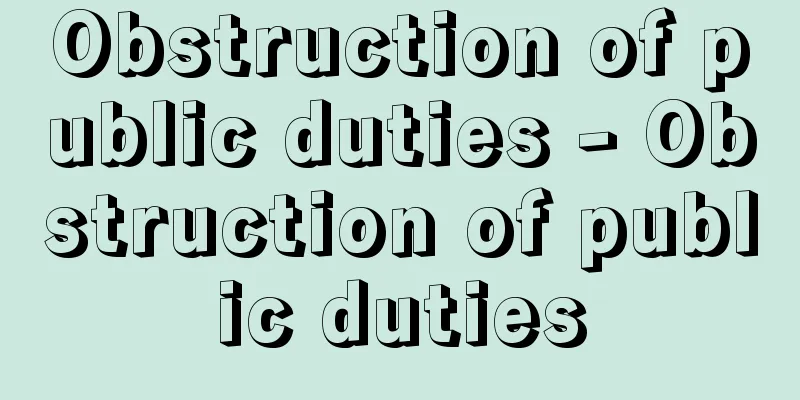Obstruction of public duties - Obstruction of public duties

|
It is a crime to obstruct a public official in the performance of his/her duties through violence or intimidation, and is punishable by imprisonment with or without work for up to three years, or a fine of up to 500,000 yen (Article 95, Paragraph 1 of the Penal Code). In a broad sense, it means "crimes of obstructing the performance of public duties" in Part 2, Chapter 5 of the Penal Code, which includes not only this crime, but also the crimes of coercion in the performance of official duties, the crime of breaking a seal, the crime of evading compulsory execution, the crime of obstructing a bidding process, and the crime of collusion (here we will discuss the crime of obstructing the performance of public duties in the narrow sense). Historically, this crime originated from the crime of resisting a government official (Article 139) in the old Criminal Code, and has the character of a crime of resistance against the power of the state. Typical examples of this crime include the use of force to resist police officers trying to stop a demonstration or arresting someone in the act of committing a crime. The object of the act in this crime is a Japanese public official. A public official generally refers to an employee who is engaged in public duties in accordance with laws and regulations (see Article 7 of the Criminal Code). In this case, public officials include those who are considered to be public officials by law, so for example, post office employees fall into this category. However, there is a dispute as to whether the duties (public duties) performed by public officials in this crime include not only the power-related public duties, but also the non-power-related or private business-related public duties performed by postal employees, etc. Case law has interpreted it as including both, but in academic theory today, the theory that it is limited to power-related public duties is more common. The issue is whether the execution of duties in this crime must be lawful, and what the requirements for lawfulness are in this case. Although there is no legal provision on this point, it is generally understood that the lawfulness of duties is required for this crime to be established. Therefore, if the illegal execution of duties by a police officer is obstructed by force, this crime will not be established, and self-defense is possible. However, regarding what is meant by the lawfulness of duties, the act performed by a public official must be within the abstract official authority of the public official and must have concrete authority, but the extent to which the official act must comply with the procedures and methods prescribed by law is also disputed. On this point, there is a view that the official act is lawful unless there is a "serious and obvious defect" and it is invalid under administrative law, but at least in cases where it has a significant impact on the freedom and human rights of citizens, this requirement should be interpreted strictly. [Tetsuro Nawa] [Reference] |Source: Shogakukan Encyclopedia Nipponica About Encyclopedia Nipponica Information | Legend |
|
公務員がその職務を執行するにあたり、これを暴行または脅迫によって妨害する罪であり、3年以下の懲役もしくは禁錮、または50万円以下の罰金に処される(刑法95条1項)。広義では、刑法第2編第5章の「公務の執行を妨害する罪」を意味し、ここには、本罪のほか、職務強要罪、封印破棄罪、強制執行免脱罪、競売入札妨害罪および談合罪が含まれる(ここでは狭義の公務執行妨害罪について述べる)。 本罪は、沿革的には、旧刑法の官吏抗拒罪(139条)に由来し、国家の権力的作用に対する抵抗罪としての性格を有する。本罪の典型的事例として、警察官によるデモ規制や現行犯逮捕に対して実力で抵抗する場合があげられる。本罪における行為の客体は日本の公務員である。公務員とは一般に、法令により公務に従事する職員をいう(刑法7条参照)。この場合の公務員には、法令により公務員とみなされる者を含むから、たとえば郵便局の職員などもこれにあたる。ただ、本罪における公務員の行う職務(公務)のなかに権力的公務のほかに郵便職員などの行う非権力的または私企業的公務も含まれるか、につき争いがある。判例は両者を含むものと解しているが、学説上は今日では、権力的公務に限るとする説がむしろ一般的である。 本罪における職務執行は適法なものであることを要するか、また、この場合に適法性の要件は何か、が問題となる。この点につき法律上の明文はないが、一般に、本罪が成立するためには、職務の適法性を要するものと解されている。したがって、警察官の違法な職務執行を実力で妨害しても、本罪は成立せず、むしろ正当防衛が可能となる。ただ、職務の適法性とは何をいうかにつき、公務員の行う行為が当該公務員の抽象的職務権限内のものであり、かつ、具体的権限を有する場合でなければならないが、さらにその職務行為が法令上の手続や方式をどの程度満たしている必要があるか、が争われている。この点につき、「重大かつ明白な瑕疵(かし)」があり、行政法上も無効でない限りその職務行為は適法であるという見解もあるが、少なくとも市民の自由や人権に重大な影響をもたらす場合には、この要件を厳格に解すべきであろう。 [名和鐵郎] [参照項目] |出典 小学館 日本大百科全書(ニッポニカ)日本大百科全書(ニッポニカ)について 情報 | 凡例 |
Recommend
Imperial territory
It refers to the total of real estate and movable...
Astley, P.
The modern circus was founded in 1770 by Philip A...
Akagi (Akagi) - Bischofia javanica
A large tree of the Euphorbiaceae family native to...
Blackbuck - blackbuck (English spelling)
An animal of the order Artiodactyla, family Bovid...
Friedrich August von Hayek
Austrian economist and thinker. Hayek's achie...
Apterygidae
... any bird belonging to the Apterygidae family ...
bokmål (English spelling) bokmal
...However, a separate language, Landsmål, was fo...
AIA - Automated Identification
Aerospace Industries Association : The American ae...
Allium thunbergii (English spelling) Allium thunbergii
… [Mitsuru Hotta]... *Some of the terminology tha...
Cum - Canel
[Verb Na-next] [Sentence] ka・nu [Na-next] One does...
rammer
… vibrating compactor A machine that compacts san...
Cantharellus aureus (English spelling)
…[Rokuya Imaseki]. . … *Some of the terminology t...
Bilbao - Bilbao (English spelling)
The capital of the province of Biscay in the Basq...
Contrast media
Apart from bones and gases inside organs, there is...
Protolepidodendrales
...The Protolepidodendrales is a group of fossil ...









